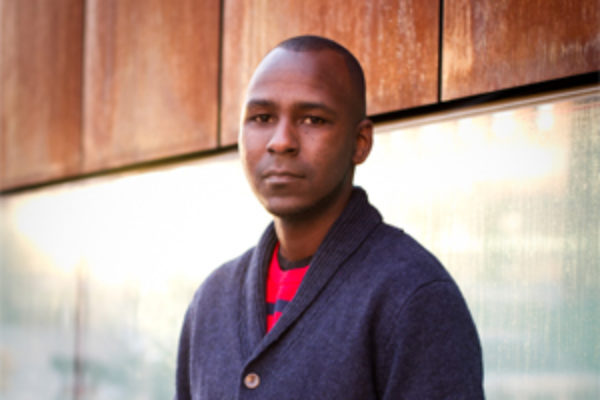 Ron Bronson is the UX strategist and service designer for the City of Bloomington, Indiana, and a partner at service experience agency Practical Starship. He’s spent over a decade working at higher ed institutions around the country in web management roles. A frequent speaker, Ron has been on stage at events including AMA Higher Ed Symposium, HighEdWeb, Elements/Penn State Web Conference, The Design & Content Conference and many others. He’s on Twitter @ronbronson and serves on the board of Indiana Design Week. We picked his brain about current web trends in higher education, and more.
Ron Bronson is the UX strategist and service designer for the City of Bloomington, Indiana, and a partner at service experience agency Practical Starship. He’s spent over a decade working at higher ed institutions around the country in web management roles. A frequent speaker, Ron has been on stage at events including AMA Higher Ed Symposium, HighEdWeb, Elements/Penn State Web Conference, The Design & Content Conference and many others. He’s on Twitter @ronbronson and serves on the board of Indiana Design Week. We picked his brain about current web trends in higher education, and more.
- What’s one thing universities should be doing on the web right now but aren’t?
Take more risks. Higher ed sites are constantly lampooned, most famously by Monsters Inc. and XKCD, because our sites are basically all the same. In a world with so many exciting things happening on the web, why aren’t our centers of innovation and research able to leverage these trends? Because of politics, constraints, talent gaps or a desire to copy what our peers are doing.
University websites have evolved to become an extension of institutional politics, rather than living versions of our often-vibrant campuses. This incongruity continues to fail our audiences.
- What’s the biggest blindspot higher education has when it comes to UX?
Developing a whole service experience. If the content on the website doesn’t match the experience people have on campus, users will notice. Working across silos to ensure there is integration with the messages we communicate and ensuring stakeholders are buying in. From a strictly user experience perspective, I’d argue that higher ed is using a limited set of user stories and research to drive entire trends of design. This myopia prevents us from recognizing the complexities of our stakeholders needs. Jaime Levy’s book UX Strategy is a good resource.
- What’s your advice to higher education web folks who are working toward better web governance?
Governance (in my opinion) is foremost about ensuring users know how content flows within the organization to the website. It’s less about edicts and while policies are important, governance is really about communication and managing people. I will say that having guidelines in place are a fundamental part of ensuring that your governance plans can take shape, so explore what other entities are doing with vision documents, content style guides and frameworks and organizational web policies.
Don’t be afraid to develop or adapt guidelines that work for your institution, rather than just trying to make ill-fitting structures work for your institution. Good references here are Lisa Welchman’s book Managing Chaos and Abby Covert’s book How To Make Sense of Any Mess; the latter more focused on information architecture, but still a very useful addition to your library.
- You’ve traveled the world presenting at conferences. Why would you encourage others to present, and what would be your advice to first-time presenters?
When I first started speaking, it was because I didn’t see people talking about the things relevant to my work at the time. Think about a talk you’ve seen at a conference or a topic you’re not hearing about, it’s probably a chance for you to share your experience.
As for advice, I’d say don’t be afraid! I’ve talked to a lot of would-be first-time speakers and across the board, I hear people say they’re afraid to getting on stage. Don’t be afraid, you know more than you think and the community needs to hear your voice. Presenting has changed my professional life immeasurably, because it’s challenged me to sharpen my own skills and to learn more. It’s also fantastic to meet awesome people from all over, who can shape and shift perspectives and help you level up both as a professional and as a colleague.
- What can higher education marketers learn from Finnish baseball?
This is a funny question. Finnish baseball (Pesäpallo) is really only popular in Finland, yet the sport has preserved and evolved for over 100 years. What does the sport have to teach higher ed marketers?
- Embrace being different. Despite American baseball being much bigger, the Finnish game has never adapted to become more like ours, they embrace the quirks that make their version of the sport different.
- Don’t be afraid to change. A scandal in the 1990s threatened to kill Pesäpallo for good. The sport changed its format and has thrived since that time.
- Know what makes your (brand/organization/institution) great and sell it. Finnish baseball performs a lot of outreach around the world to places like India, Estonia, Germany and even the USA. It might seem like a futile effort, given the obscurity of the sport, but they know what’s great about the game and if you ask anyone, they can tell you why.
- Serve your core audience. Pesäpallo is a country sport. The best teams are located in small towns around Finland and it’s survived because it’s rallied around those communities.
- What is the last song you listened to at work?
Rival Schools – Everything Has Its Point

